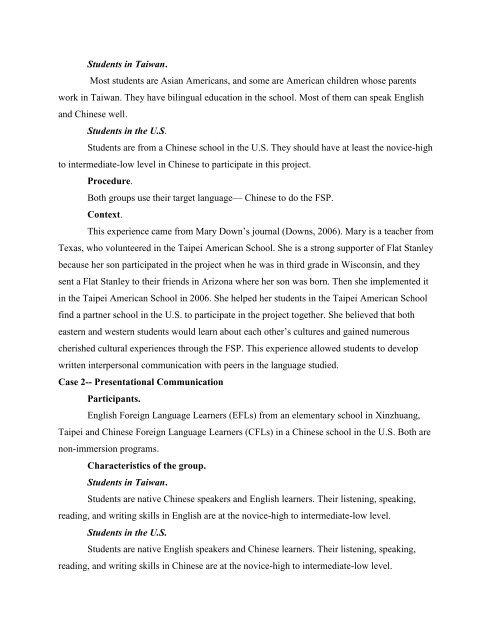K-12 Chinese Language Teaching, Issue 5
The K-12 CLT focuses on sharing experiences and exchanging ideas in teaching, research, and professional development.
The K-12 CLT focuses on sharing experiences and exchanging ideas in teaching, research, and professional development.
You also want an ePaper? Increase the reach of your titles
YUMPU automatically turns print PDFs into web optimized ePapers that Google loves.
Students in Taiwan.<br />
Most students are Asian Americans, and some are American children whose parents<br />
work in Taiwan. They have bilingual education in the school. Most of them can speak English<br />
and <strong>Chinese</strong> well.<br />
Students in the U.S.<br />
Students are from a <strong>Chinese</strong> school in the U.S. They should have at least the novice-high<br />
to intermediate-low level in <strong>Chinese</strong> to participate in this project.<br />
Procedure.<br />
Both groups use their target language— <strong>Chinese</strong> to do the FSP.<br />
Context.<br />
This experience came from Mary Down’s journal (Downs, 2006). Mary is a teacher from<br />
Texas, who volunteered in the Taipei American School. She is a strong supporter of Flat Stanley<br />
because her son participated in the project when he was in third grade in Wisconsin, and they<br />
sent a Flat Stanley to their friends in Arizona where her son was born. Then she implemented it<br />
in the Taipei American School in 2006. She helped her students in the Taipei American School<br />
find a partner school in the U.S. to participate in the project together. She believed that both<br />
eastern and western students would learn about each other’s cultures and gained numerous<br />
cherished cultural experiences through the FSP. This experience allowed students to develop<br />
written interpersonal communication with peers in the language studied.<br />
Case 2-- Presentational Communication<br />
Participants.<br />
English Foreign <strong>Language</strong> Learners (EFLs) from an elementary school in Xinzhuang,<br />
Taipei and <strong>Chinese</strong> Foreign <strong>Language</strong> Learners (CFLs) in a <strong>Chinese</strong> school in the U.S. Both are<br />
non-immersion programs.<br />
Characteristics of the group.<br />
Students in Taiwan.<br />
Students are native <strong>Chinese</strong> speakers and English learners. Their listening, speaking,<br />
reading, and writing skills in English are at the novice-high to intermediate-low level.<br />
Students in the U.S.<br />
Students are native English speakers and <strong>Chinese</strong> learners. Their listening, speaking,<br />
reading, and writing skills in <strong>Chinese</strong> are at the novice-high to intermediate-low level.


